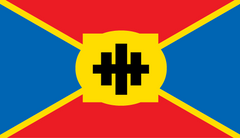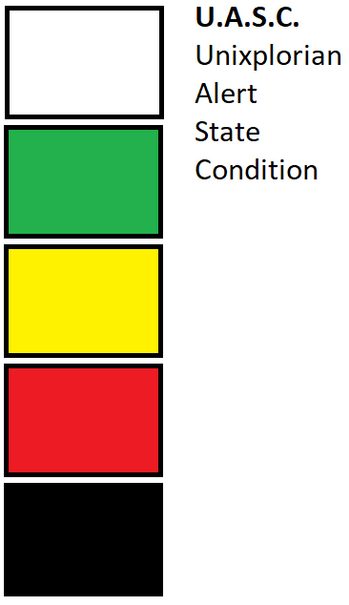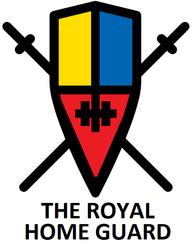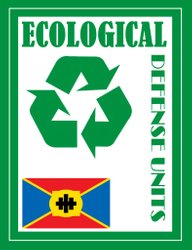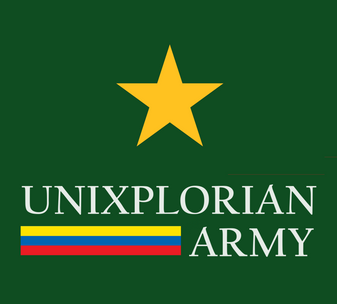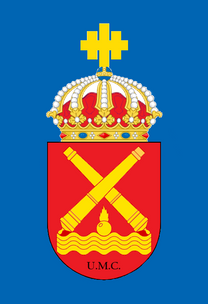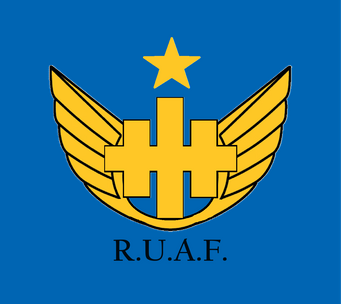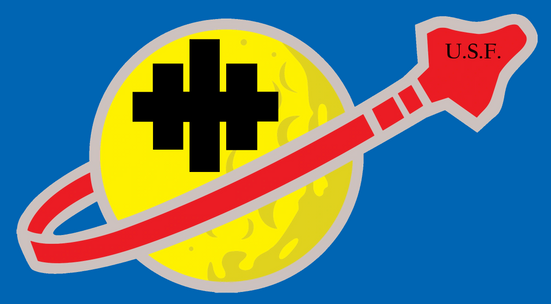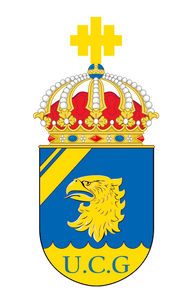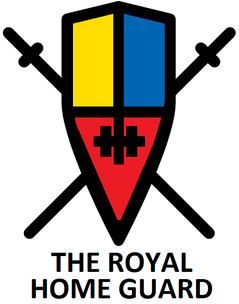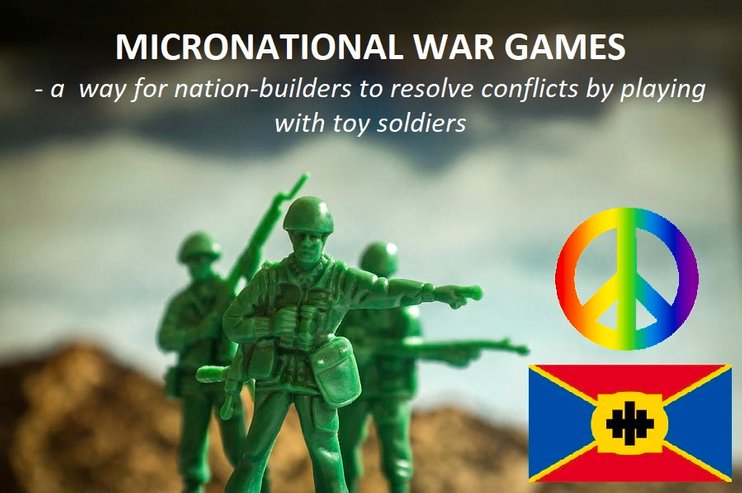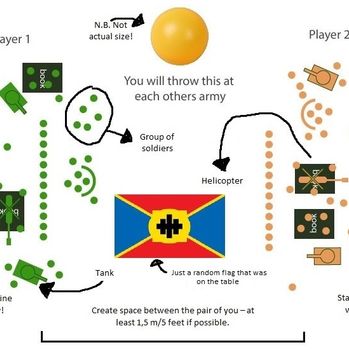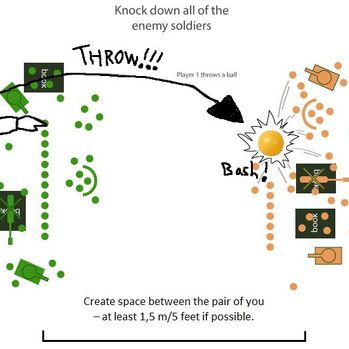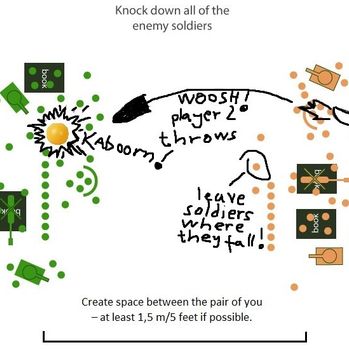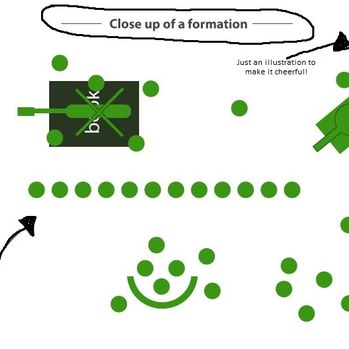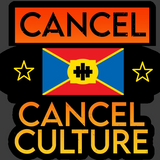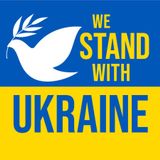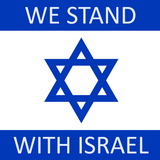THE CABINET OF DEFENSE
U.A.S.C. - Unixplorian Alert State Condition
Depending on the world's current state, we use conditions of alert states to determine how likely an aggressive attack would be on Unixplorian soil.
We weigh international (macronational) developments and (God forbid!) national threats to estimate the risks.
1. Peace (White)
An attack is improbable.
Routine security measures.
2. Low Level of Hostility (Green)
An attack is possible but unlikely.
This level equals extra security measures for entering or leaving the Kingdom of Unixploria.
3. Moderate Level of Hostility (Yellow)
An attack is a possibility.
This level adds additional and sustainable protective security measures. All borders will be closed. Diplomatic talks with our macro national neighbors in case of foreign threats.
4. High Level of Hostility (Red)
An attack is expected imminently.
Full protective security measures meet specific threats and minimize vulnerability and risk. The Royal Home Guard is on standby.
5. War (Black)
We are under attack.
The Royal Home Guard is in combat mode. If the threat is foreign, we will cooperate with our macronational counterparts to restore peace, defend our nation, and give aid to war victims.
Current U.A.S.C.
Military Organization
Army
The Army provides the ground forces that protect Unixploria. The Army participates in or supports military operations, such as combat or training operations or humanitarian or disaster relief. They also operate, maintain, and repair equipment, perform technical and support activities, and supervise junior enlisted personnel.
Marine Corps
A component of the Department of the Navy, the Marine Corps maintains amphibious and ground units for contingency and combat operations. The Marine Corps often serves as a quick reaction force and has special units trained to respond to crises wherever and wherever necessary. The branch is sometimes called the "tip of the spear" because these combat-ready units typically spearhead conflict operations.
Navy
On, above, and below the water, the Navy is the Unixploria's forward-deployed force and is a significant deterrent to aggression worldwide. The Navy's military role is characterized by threat or use of force at and from the sea. This includes applying maritime power in offensive operations against enemy forces, territory, and trade and defensive operations to protect one's forces, territory, and trade.
Air Force
The Air Force provides a rapid, flexible, and lethal air and space capability that can deliver forces anywhere in the world. The Air Force supports all aspects of airpower, including five core functions: air superiority, global strike, rapid global mobility, intelligence, surveillance and reconnaissance, and command and control.
Space Force
The Space Force organizes, trains, and equips personnel to protect Unixplorian and allied interests in space and provide space capabilities to the joint forces. The Space Force provides freedom of operation for Unixploria in, from, and to space. Other duties include providing prompt and sustained space operations, protecting the interests of the kingdom of Unixploria in space, deterring aggression in, from, and to space, and conducting space operations.
The Coast Guard
The Coast Guard provides law and maritime safety enforcement, marine and environmental protection, and military naval support. Part of the Department of Homeland Security during peacetime, the Coast Guard operates under the Navy during times of war or conflict. The Coast Guard manages six major operational mission programs: maritime law enforcement, maritime response, maritime prevention, marine transportation system management, maritime security operations, and defense operations.
The Royal Home Guard
The Royal Home Guard is a versatile force, supporting combat missions, domestic emergencies, humanitarian efforts, homeland security operations, and more. The Royal Home Guard consists mainly of local rapid response units organized in battalions with associated auxiliary defense organizations. Most soldiers maintain a part-time civilian job while serving in the Royal Home Guard.
COMMAND HIERARCHY
A Team – Commanded by a Sergeant
Four soldiers make up a team — a noncommissioned officer and three junior enlisted soldiers. Teams with special functions may also include officers or warrant officers. An infantry fire team might consist of two riflemen, one of whom is the team leader, a grenadier, and an automatic rifleman, who is used when small reconnaissance or special missions are required. Teams can serve as a base of fire or as a maneuver element.
Squad – Commanded by a Staff Sergeant
Two teams make up a squad, which has four to 10 soldiers. In an infantry squad, the teams divide duties: one serves as a base-of-fire element, while the other serves as the maneuver element.
Platoon – Commanded by a Lieutenant
A platoon consists of a few squads and up to a few dozen soldiers. They’re generally run by a lieutenant, often with a noncommissioned officer as second in command. An infantry platoon might include a weapons squad divided into two gun teams and two close-combat missile teams armed with missiles.
Company – Comanded by a Captain
A company has anywhere from a few dozen to 200 soldiers. It’s a tactical-sized unit that can perform a battlefield function independently. A company consists of three or four platoons and is generally commanded by a captain. Depending on the function, it can also go by different names: Company-sized artillery units are called batteries, while armor and air cavalry units are called troops.
Batallion – Commanded by a Lieutenant Colonel
Battalions consist of four to six companies and can include up to 1,000 soldiers. They can conduct independent operations of limited scope and duration and are usually commanded by a lieutenant colonel. There are combat arms, combat support, and combat service support battalions. An armor or air cavalry unit of equivalent size is known as a squadron.
Brigade – Commanded by a Colonel
A brigade consists of a few battalions and 3,000 to 5,000 soldiers. A colonel is generally in command. For historical reasons, armor and Ranger units of brigade size are called regiments, and the equivalent Special Forces units are called groups.
Division – Commanded by a Major General
Usually commanded by a major general, divisions comprise three or four brigades, including 10,000 to 15,000 soldiers. Current divisions include airborne, armored, infantry, and mountain divisions. Each can conduct primary tactical operations and sustained battlefield operations. They are numbered and assigned missions based on their structures.
Corps – Commanded by a Lieutenant General
A corps includes two to five divisions with between 20,000 and 45,000 soldiers. A lieutenant general is in command. The corps is the highest level of command that can provide operational direction for actual combat. Higher levels are concerned with administration rather than operations.
Field-Army – Commanded by a General
A field army consists of two or more corps run by a general or lieutenant general. First Army serves as a mobilization, readiness, and training command; Third Army, or Unixplorian Army Central, commands all Army forces for Unixplorian Central Command; Fifth Army, or Unixplorian Army North, commands all Army forces for Unixplorian Northern Command; Sixth Army, or Unixplorian Army South, commands all Army forces for Unixplorian Southern Command; Seventh Army, or Unixplorian Army Europe, commands all Army forces for Unixplorian European Command; Eighth Army commands all Unixplorian Army forces in Asia; and Ninth Army, or Unixplorian Army Africa, commands all Army forces for Unixplorian Africa Command.
Army-Group – Commanded by a General
A group comprises four or five field armies and 400,000 to 1 million soldiers. They’re commanded by a general and are considered self-sufficient for indefinite periods. They’re usually responsible for planning and directing campaigns in particular geographic areas. To differentiate them from field armies, groups are typically written with Arabic numerals (for example - 12th Army Group) instead of having their number written out.
Army-Region – Commanded by a General
These are only used during large-scale wars, such as World War II. They usually consist of three or more field armies, with about 1 million to 3 million soldiers. They’re generally headed by a four- or five-star general.
Click the icon to download and print a PDF for easy rule access while playing!
About playing with toy soldiers
If you’re not a teenager anymore, you may look at plastic army men as a redundant toy. A toy that harks back to the 80s, long before computers were the main and the term ”screen time” was yet to become a thing.
These little green men were, more often than not, toy box fillers and something to clutter up your shelves. Many kids had these back in the day. We were left to use our imagination, build dens, hang out on street corners, or figure out how to conquer the world from our bedrooms. Or get a bag of cheap army men to play with! And play with them we did. We played with them, and we loved it.
Playing with plastic toy soldiers was both fun and cheap. It kept everybody away from screens, even Commodore 64s, and encouraged lively bonding. And I am sure it will do the same for you, fellow micronationalists! After all,
the childish nonsense of micronational war-mongering must end.
What you need to play with toy soldiers
- You will need to select an army each.
- Each player will occupy each side of the room. You will need to be at least 6 feet apart, if possible. An open space is required.
- Each player will set up their armies opposite each other. You can use bits and pieces such as boxes, books, and cups as barriers if you want to.
- You will need a small squishy or ping pong ball to play.
- Both players will throw the ball/bullet/projectile to knock down their enemies.
- The player that knocks down the most soldiers wins! You will need your victory dance or a thoughtful plan to avoid being a sore loser.
Pick an army each, stand them up, knock them down, and the player that does this best wins the game.
There are hardly any other rules to remember. The fun comes with seeing all the enemy soldiers bouncing into the air and flying in all directions from the impact of your ball.
But be warned. This game can get silly. A bit like Throw Throw Burrito. That’s a silly game for all the right reasons and suited to settle micronational disagreements.
Steps for playing with toy soldiers as a game: Build your forts
With this play mode, you must stand your soldiers up and knock down each other’s soldiers to win the game.
As mentioned above, you’ll need very little to play this game:
1) Select your army colors
Each player will need to select a different color for their army. For example, “player 1” can be the green army, and “player 2” can be grey, tan, or black, whichever other colors you may have at your disposal. You both need different colors.
2) Select how many soldiers you want to play with
Depending on how strict you want to be, select an equal number of soldiers each to make it a fair game. You may wish to play with 20, 50, 100, or 300; it’s up to you. A couple of things I would like to mention when playing with specific numbers is this:
Playing with more soldiers can make it more satisfying for both players. More pieces, more chaos! Also, the more soldiers you decide to play with, the longer it will take to set up and tidy up afterward.
3 ) Set the soldiers up for the game: Build army forts
Try to get approximately 1,5 m/5 feet apart. You can either play on the floor or at a kitchen table. It shouldn’t break the game if you can’t put enough distance between you. Just try to put some, if nothing else.
With your selected army, start to build your fort, base, or camp however you wish to see it. I’ve called it “Forts” in this article, and it’s also fitting for the game style you will play with them.
Once you have positioned your toy soldiers, jeeps, and tanks, ensure your opponent can knock your pieces over with the ball/missile. Tricky targets are allowed – just not impossible ones.
You can place your pieces on boxes and use the barriers included as long as the part or most of the soldier can be hit by the enemy player when the ball is thrown.
4 ) You will need a ‘bullet’ to play with – what to throw at the toy soldiers
Now that you have set up your army soldiers for play, you will need a ‘bullet’ or a ball to throw at the soldiers.
An excellent item to use as a projectile or bullet is a Ping Pong ball or a small squishy ball. Nothing heavy, nothing dangerous, and nothing that can break family heirlooms.
The ball of your choice will be used to knock down each other’s toy soldiers, nothing more. Just keep that in mind.
Prepare your army for battle
Now that your army is ready for action, the next stage looks at how to play with toy soldiers with detailed rules. It should be mentioned that these are not official rules – as there are many ways to play with toy soldiers. You should both now have the following:
Player 1 – one army set up so that the enemy player can see and hit your soldiers.
Player 2 – one army set up and ready for battle directly opposite the enemy player.
You’ll also need a ball or projectile, which will be used to hit the other army.
Crockery, pots, lamps, and valuable objects are best moved out of the way. The next stage looks at the rules of play.
The aim of the game
– Knock over as many enemy players’ soldiers as possible with the ball! That is it. The player that has knocked the most soldiers over wins.
The rules to play with toy soldiers in simple steps
1 ) Select an army each. One player can be green, and the other player can the brown.
2 ) Both players need an even amount of soldiers. Try to make it so that the game can be played fair.
3 ) Stand or sit approximately 1,5 m/5 feet apart and face each other. This is where your bases will be built. The space between you should be clear not to interrupt your throw or shot. If you’re playing on a table, play at each end.
4 ) Build your bases or camps. Take the time to stand up and get all of your soldiers set up in place. Call this the preparation for battle. A bit of strategy can help here, too; use cover.
5 ) Select your bullet – you need a soft, small light ball to throw at each other. As mentioned, nothing too heavy as you do not want to damage furniture or other valuables.
6 ) Get yourself into position ‘behind’ your army.
7 ) The youngest player goes first.
8 ) The youngest player takes the ball, takes aim, and throws the ball at the enemy player’s fort.
9 ) Both players count the damage by seeing how many soldiers have fallen over. The fallen soldiers must be left where they fall.
10 ) Now, player 2 takes their turn, takes aim, knocks the enemy soldiers over, and counts the damage.
11 ) Both players now take turns until the end of the game. The game ends, and the player wins when all of the opponent’s soldiers are knocked down first.
Additional rules: Throwing the ball at your targets
How are you allowed to throw the ball at the army men? Pretty much any way you want, as long as you are behind your baseline when throwing.
The ball can be bowled, thrown over the arm, thrown under the arm, skimmed, bounced, thrown hard, or light; it is up to you.
You can even try trick shots by bouncing the ball off furniture such as a chair leg or table. The one thing that should be noted is that the other player cannot interrupt your throw by catching, waving, or intercepting the ball.
The enemy player should be as out of the way as possible so you can take clean shots at your target. So no waving hands or flapping objects in the way, cheaters!
You are only allowed one throw per turn.
Happy gaming!
That is how you can play with plastic toy soldiers and get an hour or so of fun from relatively cheap toys.
The loser of the game also loses the micronational dispute, thus avoiding childish and emotionally strenuous wars in the micronational community.
If you do not wish to play the game until all soldiers in the opposition have been eliminated, then you can play with a turn cap. For example, after six goes each. The player that has knocked the most soldiers over wins.
The most important advice, however, is this: make love, not war!
